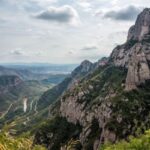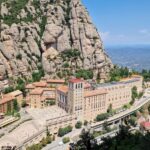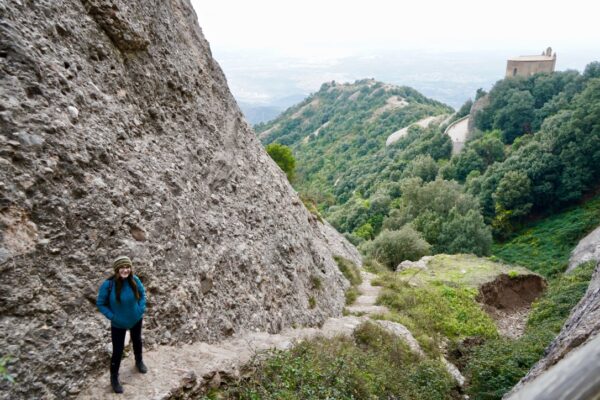
- How High Can You Hike at Montserrat? A Comprehensive Guide
- Exploring the Best Hiking Trails at Montserrat: Elevations and Difficulty Levels
- The Ultimate Experience: Reaching the Summit of Montserrat Mountain
- Safety Tips for Hiking at High Altitudes in Montserrat
- What to Expect When Hiking to the Highest Points of Montserrat
- The Best Time of Year for High-Altitude Hiking at Montserrat
Nestled just outside of Barcelona, Montserrat is a stunning mountain range that offers a unique blend of natural beauty and spiritual significance. For hiking enthusiasts and nature lovers alike, it presents an array of trails that cater to various skill levels. Understanding **How High Can You Hike at Montserrat?** is essential for planning an unforgettable outdoor adventure in this iconic landscape.
The highest peak in the Montserrat range, Sant Jeroni, stands at an impressive 1,236 meters (4,055 feet) and rewards hikers with breathtaking panoramic views. With well-marked trails and diverse scenery, Montserrat invites explorers to experience its rugged charm while challenging themselves to reach new heights in this remarkable natural setting.
How High Can You Hike at Montserrat? A Comprehensive Guide
When planning your hike in Montserrat, it's essential to understand the various trails available and their respective heights. The base of Montserrat sits at approximately 400 meters (1,312 feet), allowing for a variety of ascents. Hikers can choose trails that lead to significant elevations like Sant Jeroni, which is the highest point, or opt for more moderate paths that still offer stunning views without the strenuous climb.
For those interested in reaching new peaks, here are some notable trails to consider:
- Sant Jeroni Trail: This challenging route leads to the highest peak, offering rewarding vistas of the surrounding landscape.
- Montserrat Monastery to Sant Joan: A less intense hike that still provides impressive views and connects to the funicular station.
- Camí de les Bateries: A scenic pathway that showcases the natural beauty of Montserrat, great for families and casual hikers.
Each trail varies not only in difficulty but also in the elevation you can achieve. Here’s a quick overview of the heights associated with some of the popular hikes:
| Trail Name | Starting Point (m) | Peak Height (m) |
|---|---|---|
| Sant Jeroni Trail | 400 | 1,236 |
| Sant Joan Trail | 500 | 1,000 |
| Camí de les Bateries | 400 | 700 |
Hiking at Montserrat not only offers a chance to reach impressive heights but also an opportunity to immerse yourself in the natural and spiritual essence of the area. Whether you're a seasoned hiker or a beginner, the trails provide a unique experience of this majestic landscape, making it a destination worth exploring.
Exploring the Best Hiking Trails at Montserrat: Elevations and Difficulty Levels
When venturing into Montserrat, it's crucial to choose the right trail based on your hiking experience and preferences. The trails range in difficulty from easy strolls to challenging climbs. Hikers can enjoy a variety of terrains, including rocky paths, lush vegetation, and breathtaking vistas that showcase the stunning beauty of the region. For beginners, starting with easier hikes will allow you to gradually acclimate to the area's elevation and terrain.
Among the most popular trails, the Sant Jeroni Trail stands out for its demanding ascent, while still being achievable for determined hikers. In contrast, the Montserrat Monastery to Sant Joan route provides a gentler experience with the convenience of reaching its peak via a funicular. For families or those looking for a more leisurely outing, the Camí de les Bateries offers scenic views without the need for rigorous climbing.
To help you decide which trail to take, here’s a summary of difficulty levels and key features:
- Sant Jeroni Trail: Difficult; 1,236 meters peak; stunning panoramic views.
- Sant Joan Trail: Moderate; 1,000 meters peak; connects with funicular for easier return.
- Camí de les Bateries: Easy; 700 meters peak; family-friendly with scenic landscapes.
Whether you seek adventure, tranquility, or simply a day in nature, Montserrat's hiking trails offer something for everyone. Make sure to check trail conditions and prepare adequately for the elevations and potential challenges you may encounter. This stunning region promises an unforgettable hiking experience filled with natural beauty and spiritual exploration.
The Ultimate Experience: Reaching the Summit of Montserrat Mountain
Reaching the summit of Montserrat Mountain is not just about physical endurance; it’s about embracing the spiritual and natural beauty that surrounds you. The experience begins with the crisp mountain air and the breathtaking views that unfold as you ascend. Hikers will find that the journey to the peak offers moments of reflection, especially at the majestic Sant Jeroni, where the landscape stretches infinitely in every direction.
As you prepare for your hike, consider what to bring to ensure an enjoyable experience at Montserrat. Essential items include:
- Water: Staying hydrated is crucial during your ascent.
- Snacks: Energy-boosting snacks can help keep your spirits high.
- Proper Footwear: Good hiking boots are essential for navigating rocky paths.
- Camera: Capture the stunning vistas and unique rock formations.
Moreover, the summit experience can be enhanced by timing your hike. The early morning or late afternoon provides the best light for photography and a quieter trail experience. Observing the sunrise or sunset from the peak creates a magical atmosphere where nature and spirituality intertwine, making your hike truly unforgettable.
Finally, while reaching the summit of Montserrat is a remarkable achievement, it’s important to respect the environment. Follow the “Leave No Trace” principles to preserve this stunning landscape for future generations. By being a responsible hiker, you contribute to the maintenance of Montserrat's natural beauty and spiritual significance.
Safety Tips for Hiking at High Altitudes in Montserrat
When hiking at high altitudes in Montserrat, acclimatization is key to preventing altitude sickness. It's advisable to allow your body to adjust gradually to the changing elevation. Start with shorter hikes and progressively tackle more challenging trails. Listen to your body; if you experience symptoms like headache, nausea, or dizziness, it's essential to descend to a lower altitude immediately.
Proper hydration cannot be overstated when hiking in Montserrat's elevated terrain. Ensure you carry enough water to stay refreshed throughout your journey. High altitudes can lead to increased fluid loss, and dehydration can exacerbate altitude sickness. Aim to drink water consistently rather than waiting until you're thirsty, as this can help maintain your energy levels.
Before setting out, it’s vital to wear appropriate clothing and footwear. Dress in layers to adapt to temperature changes, as conditions can vary significantly from the base to higher elevations. Sturdy, well-fitted hiking boots will provide the necessary support and grip on rocky paths, minimizing the risk of accidents during your ascent.
Lastly, always check the local weather conditions before starting your hike. Sudden weather changes at high altitudes can pose significant challenges. Carrying a small first aid kit and letting someone know your hiking plan can provide extra safety. Following these safety tips will help ensure a memorable and enjoyable experience while hiking at Montserrat's stunning heights.
What to Expect When Hiking to the Highest Points of Montserrat
When hiking to the highest points of Montserrat, you can expect an exhilarating experience filled with stunning landscapes and diverse wildlife. As you ascend, the terrain changes, revealing unique rock formations and lush vegetation. The trails are well-marked, allowing you to navigate easily, but be prepared for steep sections that require a moderate level of fitness. Reaching the summit of Sant Jeroni is particularly rewarding, offering breathtaking views that stretch for miles across the Catalan countryside.
During your hike, it's essential to stay mindful of the weather conditions, as they can change rapidly in mountainous regions. Clear skies can quickly turn into fog or rain, impacting visibility and trail conditions. Be sure to check the forecast before your adventure and pack accordingly. Having the right gear, such as a waterproof jacket and sturdy hiking boots, can make a significant difference in your overall experience. Stay safe by informing someone of your plans and expected return time.
Reaching high elevations also presents opportunities for unique flora and fauna. Look out for native plants and bird species that thrive in the Montserrat ecosystem. The higher you climb, the more you may encounter rare species that are adapted to the altitude, providing a fascinating aspect of your hike. To enhance your experience, take breaks at scenic viewpoints, allowing you to absorb the beauty of your surroundings while resting and recharging.
Finally, remember that hiking to the highest points of Montserrat is not just about reaching the summit; it’s also about enjoying the journey. Embrace the tranquility of the mountains, and take time to reflect on the spiritual significance of this beautiful area. Whether you are seeking adventure or tranquility, the experience of hiking in Montserrat promises to leave you with lasting memories of its stunning heights and serene landscapes.
The Best Time of Year for High-Altitude Hiking at Montserrat
The best time of year for high-altitude hiking at Montserrat is during the spring and fall months. These seasons offer mild temperatures and relatively stable weather conditions, making your hiking experience more enjoyable. In spring, the trails come alive with blooming wildflowers, while fall presents a beautiful tapestry of autumn colors, providing spectacular views from the peaks.
During the summer, temperatures can soar, leading to heat exhaustion, especially at higher elevations. On the other hand, winter brings colder temperatures and the potential for snow, which can make trails treacherous. Therefore, if you plan to hike during these seasons, consider the following:
- Spring (March to May): Ideal for moderate temperatures and blooming scenery.
- Fall (September to November): Perfect for cooler hikes with stunning fall foliage.
- Summer (June to August): Hot and crowded; early mornings are best to avoid the heat.
- Winter (December to February): Cold and potentially snowy; suitable for experienced hikers only.
Additionally, consider timing your hike to catch the sunrise or sunset. These magical moments not only provide breathtaking views but also a sense of tranquility that enhances the spiritual experience of Montserrat. Early risers can enjoy cooler temperatures and fewer crowds, allowing for a more intimate connection with nature.
Overall, planning your hike at Montserrat around these seasonal considerations will significantly enhance your adventure. Whichever time you choose, be sure to check the weather forecast and trail conditions, as they can change rapidly in this mountainous region, ensuring a safe and memorable experience.
 Exploring the Mystical Beauty of Montserrat: How Long Can a Tourist Stay?
Exploring the Mystical Beauty of Montserrat: How Long Can a Tourist Stay? How Long Should I Plan to Spend in Montserrat?
How Long Should I Plan to Spend in Montserrat? Why is Montserrat a Popular Destination in Barcelona?
Why is Montserrat a Popular Destination in Barcelona? Discover the Majestic Montserrat Monastery on a Day Trip from Barcelona
Discover the Majestic Montserrat Monastery on a Day Trip from BarcelonaIf you want to know other articles similar to How High Can You Hike at Montserrat? you can visit the category WHERE YOU CAN GO.
Deja una respuesta










Read more!